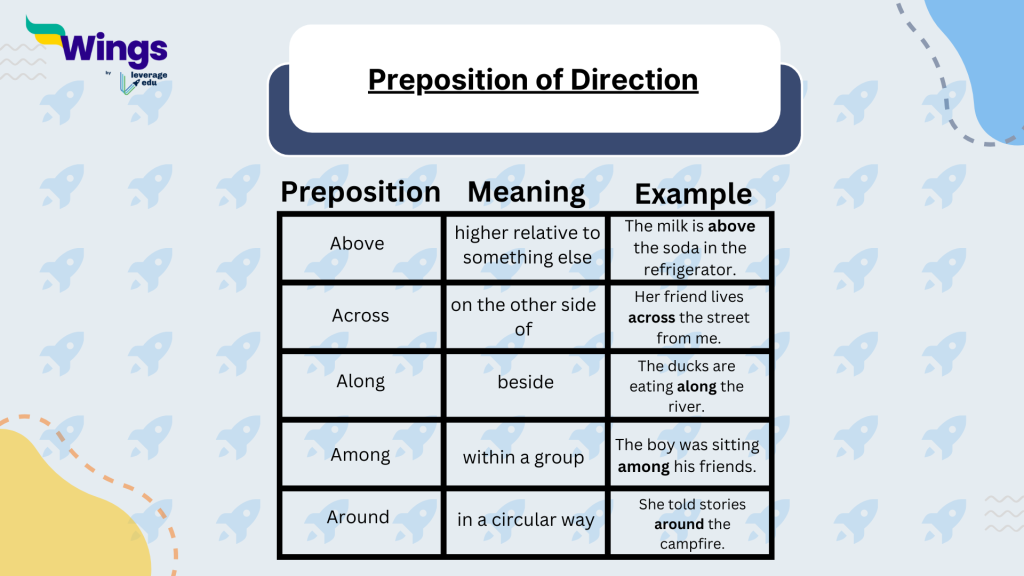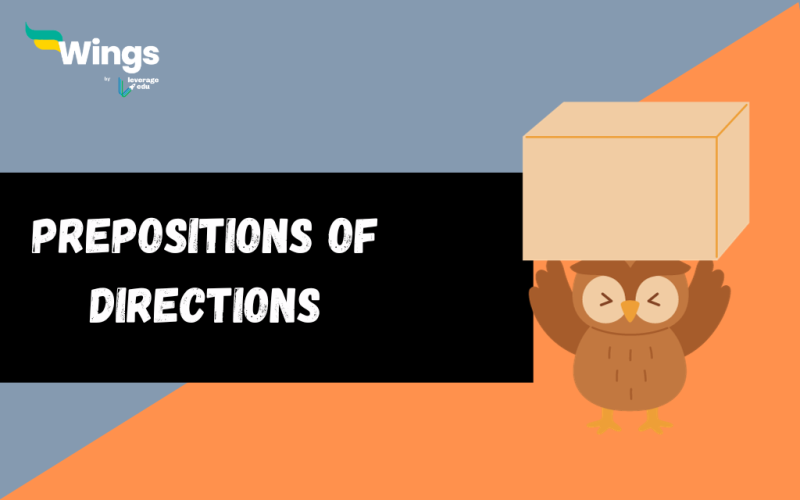Prepositions of Directions: It is usually used in English grammar to indicate the location or movement of a noun about another noun. This could refer to a person, a place or a thing. Prepositions often precede a pronoun or a noun and are accompanied by verbs of motion. If you want to learn more about prepositions of direction, then this is the best blog. In this blog, you will learn about prepositions of directions like ‘Into, onto, of, under, etc’ that are used in English communication and writing!
This Blog Includes:
What are the Prepositions of Directions?
Prepositions of direction indicate the movement of something or someone from one place to another. They answer the question “Where?” in terms of motion. They are different from prepositions of place, which describe where something is located statically. For example, “The book is on the table” uses a preposition of place, while “I walked to the library” uses a preposition of direction.
Common Prepositions of Direction
Here’s a breakdown of some of the most common prepositions of direction:
Movement Towards
- to: Indicates movement to a specific destination. Example: I’m going to the store.
- towards: Indicates movement in the general direction of something. Example: He walked towards the park.
- into: Indicates movement inside something. Example: She stepped into the room.
- through: Indicates movement from one side of something to the other. Example: The train went through the tunnel.
- along: Indicates movement in a line, following the length of something. Example: We walked along the beach.
- across: Indicates movement from one side of something to the other, often crossing a boundary. Example: She swam across the river.
- up: Indicates movement to a higher place. Example: The cat climbed up the tree.
- down: Indicates movement to a lower place. Example: The ball rolled down the hill.
- over: Indicates movement above and across something. Example: The plane flew over the city.
- under: Indicates movement below something. Example: The dog crawled under the table.
- around: Indicates movement in a circle or curve. Example: We drove around the roundabout.
- past: Indicates movement beyond something. Example: He walked past the post office.
Movement Away From
- from: Indicates the starting point of a movement. Example: I’m coming from work.
- away from: Indicates movement further from something. Example: He ran away from the danger.
- out of: Indicates movement from inside something. Example: She walked out of the building.
- off: Indicates movement away from a surface. Example: The book fell off the shelf.
Movement Within
on: Can sometimes indicate movement on a surface. Example: The car drove on the road.
in: Can sometimes indicate movement within a contained space. Example: The water swirled in the glass.
Also Read: Rules for Prepositions in English Grammar with Examples
List of 11+ Common Prepositions of Direction
Below is the list of the most common prepositions of directions we use in our everyday lives or observe in our surroundings. Let’s take a look at it.
| Across/Along/Past | Through |
| Around/Round | Up and Down |
| Into | Out of |
| Off | Onto |
| Over | Toward |
| Under | To |
| Away From | Beside |
Also Read: Learn All About Adjectives in English Grammar!
Preposition of Directions Example Sentences
Here is how the prepositions mentioned above can be used in the following sentences.
Into
- She walked into the room.
- He jumped into the water with his clothes on.
Onto
- The book fell onto the floor.
- The weather brought us onto the terrace.
- Jamie rolled onto her stomach.
Off
- She took the hat off her head.
- She was off again.
- The boy took off his clothes.
Under
- The dog came out from under the desk.
- There was a big wave and the surfer went under.
- He was standing under the tree.
Beside
Come stand beside me.
Below
I hung the poster below the mirror.
Down
The girl tumbled down the hill.
Between
The ring fell between the couch cushions.
Up
The store is right up the road.
At
Meet me at the stop sign.

Common Mistakes with Prepositions of Direction
One common mistake is confusing “to” and “towards.” “To” indicates a specific destination, while “towards” indicates a general direction. Another common error is mixing up “in” and “into.” “In” describes location inside, while “into” describes movement inside.
Tips for Learning Prepositions of Direction
- Use visuals: Draw diagrams or use maps to visualize the movement described by each preposition.
- Practice in context: Create your own sentences using the prepositions.
- Listen and observe: Pay attention to how native speakers use these prepositions in conversations and movies.
- Use flashcards: Create flashcards with the prepositions and their meanings.
- Don’t be afraid to make mistakes: Mistakes are a part of the learning process.
Also Read: 501+ Idioms with Examples and Meaning for Everyday Usage [PDF Available]
Preposition of Directions Exercise 1
Instruction: Fill in the blanks with the appropriate prepositions of directions: Toward, Onto, To, On, Into, and In:
- The dog jumped ________ the lake.
- The plane landed ________ the runway.
- The kids climbed ______ the monkey bars.
- James fell ______ the floor.
- I went ______ the gym.
Answers
- In/Into
- On
- On/Onto
- On/Onto
- To
Prepositions of Directions Exercise 2
Fill in the blanks with the correct prepositions of direction.
- Donna went ______ (down/down from/in/into/out/out of/up/up to) store, but I don’t think she found what she was looking for because she came back_______ (down/down from/in/into/out/out of/up/up to)almost immediately.
- We could see a restaurant at the bottom of the hill, so we walked ________ (down/down from/in/into/out/out of/up/up to) to see if it was open.
- You can go __________(down/down from/in/into/out/out of/up/up to) now; Dr. Wilson is ready to see you.
- As Samantha was climbing _______ (down/down from/in/into/out/out of/up/up to) the swimming pool, she slipped and fell back _________ (down/down from/in/into/out/out of/up/up to).
- She didn’t have any difficulty pulling _______ (down/down from/in/into/out/out of/up/up to) the parking space, but as she was backing __________ (down/down from/in/into/out/out of/up/up to), she scratched the car standing next to her.
Answers:
- Down, up
- Down
- In
- Into, Into
- Into, Up
Prepositions of Directions Exercise 3

Also Read: Top World’s Hardest Tongue Twisters: For Voice Actors, Students
FAQs
Prepositions are often used in a sentence to refer to the time of something happening. They can be used to denote the position or location of an object.
It is a simple single-word preposition that expresses relationships of time, place manner, direction or other relationships. They are the most basic and commonly used prepositions.
Prepositions usually appear before a noun or pronoun. It establishes a relationship between pronouns, nouns or any other parts of the sentence.
Prepositions of place describe a static location (where something is), while prepositions of direction describe movement (where something is going). For example, “The book is on the table” (place) vs. “I put the book onto the table” (direction).
Try to visualise the movement described by the preposition. For example, “over” often involves movement above and across something, while “under” involves movement below. Pay attention to the specific nuances of each preposition.
They are essential for clear and accurate communication. Without them, it would be difficult to give directions, describe travel, or talk about movement in general. They are fundamental to expressing spatial relationships.
To advance your grammar knowledge and read more informative blogs, check out our Learn English page and don’t forget to follow Leverage Edu.
 One app for all your study abroad needs
One app for all your study abroad needs















 60,000+ students trusted us with their dreams. Take the first step today!
60,000+ students trusted us with their dreams. Take the first step today!

